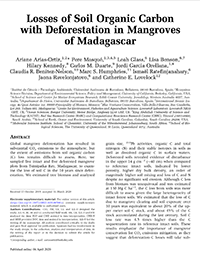Abstract
Global mangrove deforestation has resulted in substantial CO2 emissions to the atmosphere, but the extent of emissions from soil organic carbon (C) loss remains difficult to assess. Here, we sampled five intact and five deforested mangrove plots from Tsimipaika Bay, Madagascar, to examine the loss of soil C in the 10 years since deforestation. We estimated tree biomass and analyzed grain size,210Pb activities, organic C and total nitrogen (N) and their stable isotopes in soils as well as dissolved organic C in surface waters.Deforested soils reveal ed evidence of disturbance in the upper 14 g cm-2(40 cm) when compared to reference intact soils, indicated by lower porosity, higher dry bulk density, an order of magnitude higher soil mixing and loss of C and N despite no significant soil erosion. Although C loss from biomass was unequivocal and was estimated at 130 Mg C ha-1, the C loss from soils was more difficult to assess given the large heterogeneity of intact forest soils. We estimated that the loss of C due to mangrove clearing and soil exposure over 10 years was equivalent to about 20% of the up-per meter soil C stock, and about 45% of the C stock accumulated during the last century. Soil C loss rate was 4.5 times higher than the C sequestration rate in reference intact soils. These results emphasize the importance of mangrove conservation for CO2 emissions mitigation, as they suggest that deforestation-C losses will take substantially longer to offset with mangrove restoration.
Keywords:
Mangroves; Deforestation; Soil carbon; Soil disturbance; CO2 emissions; Madagascar












